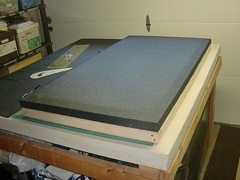What should be the aspects to be approached when looking for good acoustics? The most important would be:
- Flat frequency response:
- Balanced reverberation characteristics:
- Controlled early reflections:
- Balanced stereo image:
The main goal of a room with good acoustics is achieving neutrality. One has to listen to what is in the recording itself, not to what goes through the sonic filtering of the room.
To achieve such a goal it is fundamental to understand how sound behaves and develops within a room in which ways its quality might be degraded.
Then, we must learn methods and procedures that will be used to correct these deviations in acoustic quality.
Sound travels in different ways:
-
-Airborne: sound transmitted by compression and rarefaction of air particles. Air is a very powerful sound transmission medium and can put down all best efforts on heavy walls and windows. A surface with 13% of its area perforated can still transmit 97% of the sound hitting it. That’s why a well isolated room has to be airtight.
-
-Carried by structure: although making a solid structure vibrate by airborne noise is difficult (air is very elastic and solids very stiff), noise mechanically transmitted to structure (i.e. slamming door, electric motors, etc.) are very efficiently propagated (6dB of attenuation per 100m!!)
-
-Diaphragmatic action: thin, large panels (such as walls or windows) can be made vibrate by external airborne sound and then leak this into the interior via sympathetic vibration or structural transmission.






